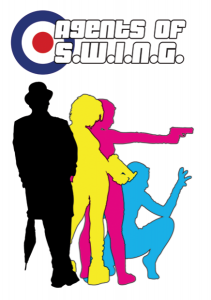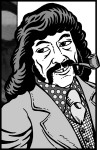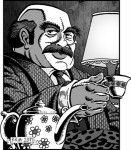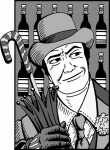Agents of S.W.I.N.G.
Agents of S.W.I.N.G. is a complete role-playing game powered by the FATE system and published by Postmortem Studios.
By James Desborough

Welcome to the eleventh Designer’s Diary, a regular column where designers are given the opportunity to take readers on an in-depth ride through the design and development process of their system, setting, or product.

How to Describe Agents of SWING?
Agents of SWING is an affectionate homage to the adventure and Spy-Fi serials of the 60s and 70s. Everyone’s familiar with James Bond but there’s a whole rich tapestry of adventure television – much of it British – stemming from the swinging 60s and the grittier 70s from The Avengers, The Persuaders and The Protectors to the more outré Sapphire and Steel or Randall and Hopkirk (Deceased).
Agents of SWING mashes all of these serials together into a single FATE-powered world, crossing them over and setting SWING – The Supreme World Intelligence Network Group against the various nefarious organisations seeking to destabilise the world or bring on World War Three.
It’s a free-wheeling setting and system that can be played on any range from Austin Powers camp to the relative seriousness of The Man in Room 17 or Callan.

Why did I develop Agents of SWING?
I’d wanted to do something with FATE for a while but have found so many of its implementations bulky and, while simple, off-putting for some people because of the sheer size. I wanted to simplify and slim down the system and I saw it as perfect for a Spy-Fi setting, something that hadn’t been done before – at least not quite like this.
I didn’t manage to slim down the rules as much as I would have liked to, but that’s partly to do with formatting. Otherwise I think the simplification of the system went quite well and has left a solid basis for future development of other games.
What were my main influences?
Obviously the television series mentioned before were the major influence. Game-wise I based the SWING rules set around Cubicle 7’s Starblazer Adventures and Legends of Anglerre, at least as a foundation, though many rules have changed, been excised or streamlined in one way or another. Of the televisual and filmic influences, The Avengers and James Bond have always had the most influence over me, though there’s plenty of others in there.
What Research did I do?
I watched a lot of repeats on daytime satellite television and spent a lot of time on Youtube looking at clips. There are also innumerable fan sites out there for all these old shows and failing that there’s always Wikipedia. I must have read the FATE SRD, Starblazer and Anglerre about twenty times and I did a lot of playtesting and ideas-bouncing at UK conventions (Dragonmeet and Indiecon) as well as with my semi-regular gaming groups.

What was the art direction?
My aim was to create something clear, concise and readable. There would not be too much information on any page and the style would be – so much as possible – 60s minimalist with plenty of repeated references to make it a very playable book. I think that was achieved. Elements are repeated, the pages are consistent through the book – with some early psychedelia and a lot of Bondian feminine silhouettes spread throughout the book. The mugshots are all consistently done in fine style by veteran gaming artist Brad McDevitt, who did a bang up job. SWING has a very clean and presentable style that I hope to carry throughout the entire line.

What’s the Gaming Experience of Playing SWING?
Hectic, headlong adventure with an emphasis on style and the personal strengths of the agents. It can be a pick-up-and-play game but it really benefits from a little thought on the part of the GM (called Control in this game) to put the plot and the trail of clues in position. Once you’re actually playing, everything seems to flow pretty smoothly and people seem to have a lot of fun and that’s the main thing, playing up to the stereotypes of the fiction of the time and having fun.

How does SWING compare to similar products?
Setting-wise there isn’t a lot out there that competes. There’s some setting material for games like Spycraft and the old James Bond RPG, or Top Secret (SI) but nothing throws it all together quite like SWING does and I think I’ve succeeded in creating an engaging world of endless possibilities, open enough for people to enjoy on their own terms while still giving them plenty of ideas.
System-wise it obviously compares to other FATE games but with the streamlining and simplification – going against the grain of many newer FATE releases – I think it’s been taken back somewhat to its root of being an easily grasped and flexible system. Of all the other FATE games it, therefore, probably compares most readily with Spirit of the Century, pulp and Spy-Fi having a lot in common. SWING is more… liberal with the FATE points and the power of aspects though, as well as allowing for individual character creation and making it much easier to select Skills and Stunts.

What is my Development Process?
My development process goes something like this:
- Have an idea.
- Write the idea down in my ‘to do list’.
- Finish whatever it is I’m currently working on.
- Read through the to-do list.
- Pick the project I want to do next.
- Decide on a system and the broad themes.
- Adapt the system, jot down the basic themes and ideas.
- Playtest the adapted system and make corrections if need be.
- Put together a full working version of the system and flesh out the background some more.
- More testing/playing/run scenes/scenarios with myself and with others.
- Work out the ‘skeleton’ of the book. Chapters, headings, subheadings.
- Commission the art.
- Work through from start to finish.
- Get friends/family/random strangers to read through the manuscript.
- More testing.
- Finalise the text, get the art in.
- Do layout.
- Put the game up for sale!
- Profit.





